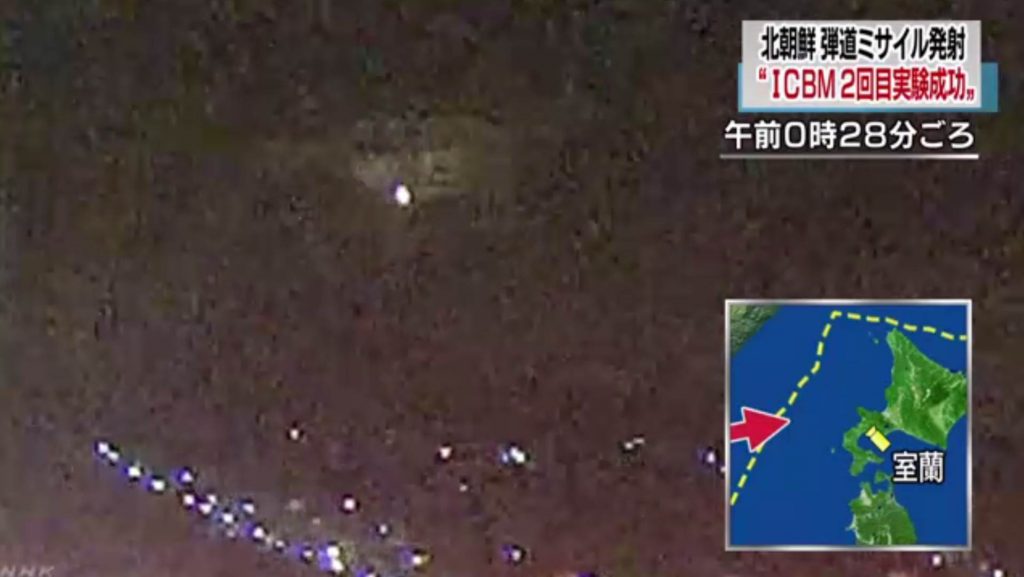Video Casts Doubt on North Korea’s Ability to Field an ICBM Re-entry Vehicle
With its second—apparently successful—flight test of the Hwasong-14 on July 28, North Korea may soon be able to field an intercontinental ballistic missile (ICBM). However, a number of critical questions remain about how soon Pyongyang could field a reliable weapon, not the least of which is whether or not North Korea can shield a nuclear warhead from the rigors of re-entry into the earth’s atmosphere at ICBM velocities.[1] Video of the Hwasong-14 test has emerged that casts doubt on the North’s ability to do so.
The Japanese television station, NHK, has a weather camera mounted on the roof of its Hokkaido Prefecture affiliate, located in Muroran City. The camera looks east, across a bay, and in the direction where the Hwasong-14’s re-entry vehicle (RV) crashed into the sea, about 200 km from Japan. Based on the camera’s position, and the RV’s impact point, the camera’s view is obscured by the small mountain range located across the bay and the earth’s curvature when the RV is about 2 km above the ocean’s surface.

Given the range, peak altitude and time of flight of the Hwasong-14 test, the RV is traveling at just over 6 km per second when it enters the atmosphere. At about 25 to 30 km altitude, the air is dense enough to slow and heat the RV. At about 20 km above sea level, the RV has become so hot that it begins to glow as its descent is recorded by the camera. It continues to slow and its temperature further rises as it approaches impact with the sea.
In the video, peak radiance—when the clouds reflect the RVs radiance resulting in a bright flash—occurs when it is at 6 to 8 km altitude, and a fraction of a second before it passes through or behind a layer of clouds. Soon after the flash, the RV descends to roughly 4 or 5 km altitude, where the frictional forces that slow and heat the RV reach a maximum. At this point, the RV appears to be shedding small radiant objects and is trailed by an incandescent vapor. At an altitude of 3 to 4 km, the RV then dims and quickly disappears. This occurs before the RV passes behind the mountain range and is obscured from the camera’s view, indicating that it disintegrated about the time it experienced maximum stressing loads. Had the RV survived the rigors of re-entry, it would have continued to glow until disappearing behind the mountains.
In short, a reasonable conclusion based on the video evidence is that the Hwasong-14’s re-entry vehicle did not survive during its second test. If this assessment accurately reflects reality, North Korea’s engineers have yet to master re-entry technologies and more work remains before Kim Jong Un has an ICBM capable of striking the American mainland.
- [1]
One outstanding question is the issue of reliability. If the Hwasong-14 undergoes a handful of additional flights, Pyongyang will have established that the missile is likely to reach America successfully more often that it is likely to fail. This may suffice if Kim’s primary objective is to sow enough fear that an American city is vulnerable to nuclear destruction that Washington will be deterred from attacking his country. If Pyongyang demands greater confidence in the Hwasong-14’s reliability, it can continue testing the missile after it has been deployed.
Another is whether North Korea can miniaturize a nuclear warhead sufficient to place on top of an ICBM. No one outside of North Korea knows the precise status of its nuclear-bomb making capabilities. However, it is reasonable to assume North Korea can construct a bomb that weighs less than one-metric ton, with a diameter of less than one meter. This could be easily carried by the Hwasong-14, though to reach the U.S. mainland, a lighter-weight bomb may be required.
